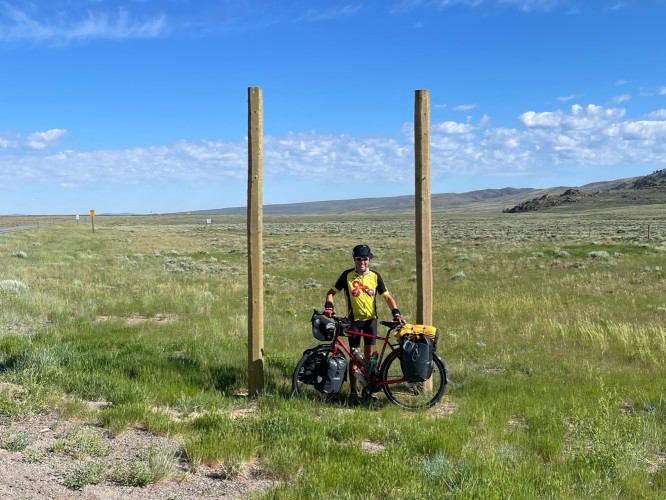Dick Hagan, who has Usher Syndrome, decided to bike across the country.
By Kirsten Ballard
Dick Hagan dipped the back tire of his bike in the Chesapeake Bay in Yorktown, VA on April 29, 2022. The moment launched an 85-day ride across the country to Florence, Oregon where Hagan’s front tire met the Pacific.
The 4,208 mile ride is an impressive feat for anyone. Even more impressive when Hagan admits he got back into cycling at age 50 and completed the ride at 61 years old. Oh – and he’s deaf and legally blind.
Hagan was diagnosed with hearing loss before he was two and fitted with a hearing aid “the size of a deck of cards” when he was about five years old. Then in his early teens, he began to have trouble seeing in the dark. He was diagnosed with Usher Syndrome, a genetic condition where hearing and vision progressively degenerate.
He has type 2A Usher Syndrome which means his hearing loss is stable but his vision loss progressively got worse. He was declared legally blind in 2016 and went on disability in 2019.
On his blog, crazyguyonabike.com, Hagan both detailed his transAmerica ride and shares information about Usher Syndrome.
“I did not do this bike tour just to raise Usher Syndrome awareness but I did raise awareness while following my passion,” he says.
On his site, Hagan illustrates his vision loss and how Ushers has manifested for him. “For vision, I do not have any peripheral vision so imagine looking through a drinking straw through several layers of dirty window screens. And I don’t see much in a dimly lit environment, so on a clear full moon night, I would only see the moon and everything else is all black, I wouldn’t be able to find one star or see you standing next to me. I need assistance inside all buildings due to the artificial lighting,” he says.
Hagan says a common misconception he gets is that people think of deaf and blind as insular diagnosis and not a sliding scale. “People seem to understand when someone is hard of hearing because of hearing aids but with vision, people think either eyes work or they do not and nothing in between.
When he was diagnosed, Hagan says he took the news okay. “I was a young teenager feeling invincible…but my mom cried the entire hour drive home. I sat in the back seat looking at her telling myself, ‘Well, I’m not blind yet’ and still have that attitude to this day,” he says.
It was that attitude that gave him the moxie to attempt (and complete) his transAmerica ride. Inspired by journals and audiobooks of bike tours, Hagan mapped out the 76 day ride and rest days with the only goal of being in Pueblo, Colorado by June 15th.
Before he pushed off from Virginia, Hagan had only done week-long self-supported rides over the last 10 summers but says it was nothing like this undertaking.
Hagan was accompanied by two guide cyclists–Greg Holm, who Hagan has known since middle school and Wade Bloecher, who he met in a local bike club 10 years ago.
“My guide cyclists know my limitations pretty well and I would have only gone if I trusted them 100 percent,” he says. “I hope they love their life as much as I love mine and do not take risks with a deaf-blind cyclist in tow.”
He says that they did not plan more than a few days in advance. “It’s nearly impossible to plan out for the entire tour with inclement weather, mechanical failure, illness and/ or injury.” Hagan had a crash in Lexington, Virginia because of a lip in the road. He suffered road rash, a bruised hip and bruised jaw but continued on.
“The tour was more of a barrier than I thought,” he says. “I didn’t realize how blind I am until I got out of my comfort zone.”
He thinks eventually his vision degeneration will make his road cycling impossible. But he says he plans to transition to indoor cycling and pedaling virtually all around the world.
“Ability is stronger than disability and focus on what you can hear and see and not on what you do not see or do not hear,” he says.

